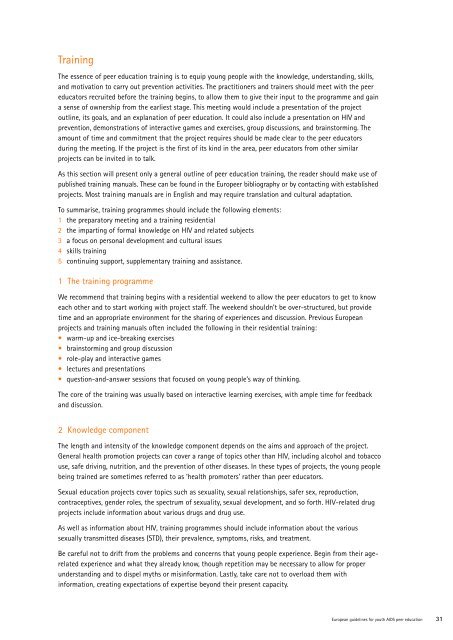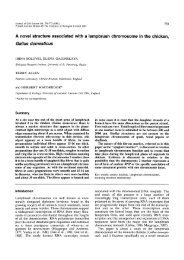European guidelines for youth AIDS peer education - University of ...
European guidelines for youth AIDS peer education - University of ...
European guidelines for youth AIDS peer education - University of ...
- No tags were found...
You also want an ePaper? Increase the reach of your titles
YUMPU automatically turns print PDFs into web optimized ePapers that Google loves.
TrainingThe essence <strong>of</strong> <strong>peer</strong> <strong>education</strong> training is to equip young people with the knowledge, understanding, skills,and motivation to carry out prevention activities. The practitioners and trainers should meet with the <strong>peer</strong>educators recruited be<strong>for</strong>e the training begins, to allow them to give their input to the programme and gaina sense <strong>of</strong> ownership from the earliest stage. This meeting would include a presentation <strong>of</strong> the projectoutline, its goals, and an explanation <strong>of</strong> <strong>peer</strong> <strong>education</strong>. It could also include a presentation on HIV andprevention, demonstrations <strong>of</strong> interactive games and exercises, group discussions, and brainstorming. Theamount <strong>of</strong> time and commitment that the project requires should be made clear to the <strong>peer</strong> educatorsduring the meeting. If the project is the first <strong>of</strong> its kind in the area, <strong>peer</strong> educators from other similarprojects can be invited in to talk.As this section will present only a general outline <strong>of</strong> <strong>peer</strong> <strong>education</strong> training, the reader should make use <strong>of</strong>published training manuals. These can be found in the Euro<strong>peer</strong> bibliography or by contacting with establishedprojects. Most training manuals are in English and may require translation and cultural adaptation.To summarise, training programmes should include the following elements:1 the preparatory meeting and a training residential2 the imparting <strong>of</strong> <strong>for</strong>mal knowledge on HIV and related subjects3 a focus on personal development and cultural issues4 skills training5 continuing support, supplementary training and assistance.1 The training programmeWe recommend that training begins with a residential weekend to allow the <strong>peer</strong> educators to get to knoweach other and to start working with project staff. The weekend shouldn’t be over-structured, but providetime and an appropriate environment <strong>for</strong> the sharing <strong>of</strong> experiences and discussion. Previous <strong>European</strong>projects and training manuals <strong>of</strong>ten included the following in their residential training:• warm-up and ice-breaking exercises• brainstorming and group discussion• role-play and interactive games• lectures and presentations• question-and-answer sessions that focused on young people’s way <strong>of</strong> thinking.The core <strong>of</strong> the training was usually based on interactive learning exercises, with ample time <strong>for</strong> feedbackand discussion.2 Knowledge componentThe length and intensity <strong>of</strong> the knowledge component depends on the aims and approach <strong>of</strong> the project.General health promotion projects can cover a range <strong>of</strong> topics other than HIV, including alcohol and tobaccouse, safe driving, nutrition, and the prevention <strong>of</strong> other diseases. In these types <strong>of</strong> projects, the young peoplebeing trained are sometimes referred to as ‘health promoters’ rather than <strong>peer</strong> educators.Sexual <strong>education</strong> projects cover topics such as sexuality, sexual relationships, safer sex, reproduction,contraceptives, gender roles, the spectrum <strong>of</strong> sexuality, sexual development, and so <strong>for</strong>th. HIV-related drugprojects include in<strong>for</strong>mation about various drugs and drug use.As well as in<strong>for</strong>mation about HIV, training programmes should include in<strong>for</strong>mation about the varioussexually transmitted diseases (STD), their prevalence, symptoms, risks, and treatment.Be careful not to drift from the problems and concerns that young people experience. Begin from their agerelatedexperience and what they already know, though repetition may be necessary to allow <strong>for</strong> properunderstanding and to dispel myths or misin<strong>for</strong>mation. Lastly, take care not to overload them within<strong>for</strong>mation, creating expectations <strong>of</strong> expertise beyond their present capacity.<strong>European</strong> <strong>guidelines</strong> <strong>for</strong> <strong>youth</strong> <strong>AIDS</strong> <strong>peer</strong> <strong>education</strong> 31
















